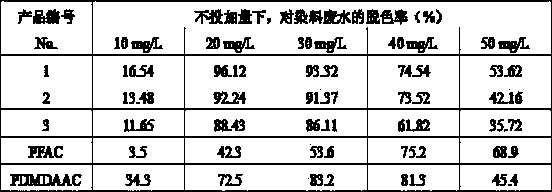Polyaluminum ferric chloride-polyepichlorohydrin-ethylene diamine preparation method
A technology of polyepichlorohydrin and polyaluminum ferric chloride, which is applied in the direction of flocculation/sedimentation water/sewage treatment, etc., to achieve the effects of dense alum flowers, reduced dosage, and fast reaction speed
- Summary
- Abstract
- Description
- Claims
- Application Information
AI Technical Summary
Problems solved by technology
Method used
Image
Examples
Embodiment 1
[0022] (1) Take 24mL of liquid paraffin in a 250mL four-necked round bottom flask with a stirrer and a reflux condenser, place the flask in an ice-water bath, and control the temperature at 8°C , And feed nitrogen into the flask for 20 min (the flow rate is 0.5m 3 / h), then weigh 6.02 g of ethylenediamine into the round bottom flask (the mass ratio of ethylenediamine to liquid paraffin is 1:3), turn on the cooling water of the reflux condenser, and stir at G value of 150 S -1 While stirring, the temperature was raised to 25 °C, and 18.56 g of epichlorohydrin (the molar ratio of epichlorohydrin to ethylenediamine was 2:1) was slowly added dropwise with a separatory funnel for addition reaction, and the dropping time was 2.5 hours. Continue to stir for 60 minutes after the dropwise addition; then lower the temperature below 15°C, add 33% trimethylamine aqueous solution cross-linking agent according to the molar ratio of trimethylamine and epichlorohydrin as 1:1.5; raise the temp...
Embodiment 2
[0027] (1) Take 24mL of liquid paraffin in a 250mL four-necked round bottom flask with a stirrer and a reflux condenser, place the flask in an ice-water bath, and control the temperature at 5°C , And feed nitrogen into the flask for 15 min (the flow rate is 0.5m 3 / h), and then weigh 6.02 g of ethylenediamine into the round bottom flask, open the cooling water of the reflux condenser, and stir at G value of 250 S -1While stirring, the temperature was raised to 20 °C, and 18.56 g of epichlorohydrin (the molar ratio of epichlorohydrin to ethylenediamine was 2:1) was slowly added dropwise with a separatory funnel for addition reaction, and the dropping time was 2 hours. Continue stirring for 60 minutes after the dropwise addition; then lower the temperature below 15°C, add 33% trimethylamine aqueous solution cross-linking agent according to the molar ratio of trimethylamine and epichlorohydrin as 1:1.5; raise the temperature again to 90°C, react at constant temperature for 5 hou...
Embodiment 3
[0032] (1) Take 24mL of liquid paraffin in a 250mL four-neck round bottom flask with a stirrer and a reflux condenser, place the flask in an ice-water bath, and control the temperature at 0°C , And feed nitrogen into the flask for 17 min (the flow rate is 0.5m 3 / h), then weigh 6.02 g of ethylenediamine into the round bottom flask, open the cooling water of the reflux condenser, and stir the G value to 200 S -1 Heat up to 23 °C while stirring, and slowly add 18.56 g of epichlorohydrin (the molar ratio of epichlorohydrin to ethylenediamine is 2:1) dropwise with a separatory funnel for addition reaction, and the dropping time is 3 hours for aqueous solution After the dropwise addition, continue to stir for 60 minutes; then lower the temperature to 15°C, and add 33% trimethylamine aqueous solution cross-linking agent according to the molar ratio of trimethylamine and epichlorohydrin as 1:1.5; raise the temperature again to 85°C, react at constant temperature for 5 hours, and nat...
PUM
 Login to View More
Login to View More Abstract
Description
Claims
Application Information
 Login to View More
Login to View More - R&D
- Intellectual Property
- Life Sciences
- Materials
- Tech Scout
- Unparalleled Data Quality
- Higher Quality Content
- 60% Fewer Hallucinations
Browse by: Latest US Patents, China's latest patents, Technical Efficacy Thesaurus, Application Domain, Technology Topic, Popular Technical Reports.
© 2025 PatSnap. All rights reserved.Legal|Privacy policy|Modern Slavery Act Transparency Statement|Sitemap|About US| Contact US: help@patsnap.com

